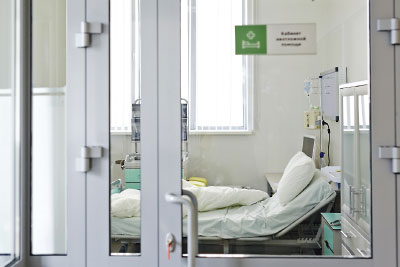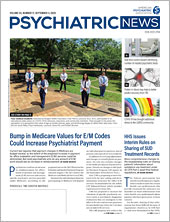Sixty-five years ago, there were 558,922 inpatient psychiatric beds—or 337 beds per 100,000 population—most of them in state hospitals at a time when there were almost no community-based services for people with serious mental illness.
A great many of those beds were occupied by patients who today would never be in a state hospital—elderly people with dementia, individuals with intellectual disabilities, even patients with venereal diseases.
By 2014, there were just 37,209 state beds, or 11.7 beds per 100,000 population; of those, 17,046 were occupied by forensic patients, according to a 2017 report by the National Association of State Mental Health Program Directors (NASMHPD) and the Treatment Advocacy Center (TAC) titled “Beyond Beds.”
But between 1955 and 2014, there also grew up a wide range of community services, as well as other bedded psychiatric services that had not existed when state hospitals were dominant. In 2014, the latter included inpatient psychiatric beds in general hospitals with separate psychiatric units (30,864), inpatient beds in private psychiatric hospitals (24,804), inpatient psychiatric patients who were placed in medical/surgical units (an arrangement referred to as “scatter beds” of which there were 8,006), inpatient psychiatric beds in Veterans Affairs hospitals (3,124), and inpatient beds in other specialty mental health centers (3,499).
Adding to the calculation complexity are psychiatric beds in nursing homes and various kinds of residential treatment centers and settings (child and adolescent and geriatric facilities, rehabilitation facilities, group homes) that were not reportable to public agencies.
Because beds are distributed in a wide array of places, it’s much more difficult to count beds than it was 65 years ago, said Debra Pinals, M.D., a co-author of the NASMHPD report and chair of a subgroup of the APA Presidential Task Force on Assessment of Psychiatric Bed Needs in the United States. The task force was created by APA President Jeffrey Geller, M.D., M.P.H. (see
Psychiatric News). The task force is charged with producing a model for use by a community to determine the number of psychiatric beds it needs.
The subgroup is looking at this question: How can an accurate number of beds be determined in a community when the beds that exist are scattered throughout a fragmented system?
“There are many complexities to the system, related to availability of services, funding, staffing, philosophy, mental health laws, demographics, and social determinants in a region, that all come together in a particular jurisdiction,” Pinals told Psychiatric News.
Pinals is joined on the subgroup by past APA President Anita Everett, M.D., and Ted Lutterman, senior director of government and commercial research with the NASMHPD Research Institute.
In an interview with Psychiatric News, Lutterman—who has done extensive research in the area of community psychiatric capacity—said arriving at the right number of inpatient beds is dependent on the resources available in the community for patients who can be treated in a less intensive setting.
“What we know is that inpatient care is an incredibly expensive service that is nevertheless essential for people with critical needs,” he said. “How many beds you need is not just a matter of saying ‘We need X number per 100,000.’ You have to factor in community resources, including the beds that may exist in disparate settings and systems.”
The kind of community resources that can influence the number of acute care beds needed in the community include the presence of Assertive Community Treatment (ACT) teams, proven over decades to be effective in maintaining patients with serious mental illness in the community.
Crisis Now is a project of NASMHPD and four partners to provide safe, effective crisis care that diverts people in distress from the emergency department and jail by developing a continuum of crisis care services that match people’s clinical needs. The other partners are the National Action Alliance for Suicide Prevention, the National Suicide Prevention Lifeline, the National Council for Behavioral Health, and RI International.
(Another subgroup of the task force, chaired by Isabell Norian, M.D., is looking at defining the “ideal” for other components across the continuum of care that invariably impact the need for acute care beds.)
Lutterman said NASMHPD and the Substance Abuse and Mental Health Services Administration (SAMHSA) are working with states to develop state-based registries of inpatient beds available for patients in psychiatric crisis.
In addition to arriving at a good count of beds, a goal of the state-based registries is to identify where the bottlenecks are in the system that result in patients getting stuck in emergency department or in jails, Luterman said. “One of the things that is helpful about this [project] is that it allows a state to identify where in the state geographically there are roadblocks or shortages and not enough capacity.”
Virginia developed its own registry following the 2013 suicide of the son of Virginia state Sen. Creigh Deeds. Lutterman said that Deeds’ son, who had severe mental illness, was in crisis at the time, and there appeared to be no open inpatient psychiatric beds in the state. After the young man died by suicide, it was determined that beds had been available but were not readily identifiable.
Lutterman said the SAMHSA/NASMHPD registry effort can inform the work of the subgroup and the model developed by the APA task force. “We are really hoping to feed into Dr. Geller’s model and provide some quantitative data—not only on where there are shortages in our system, but also what types of beds are in short supply.”
He added, “Psychiatric inpatient care is incredibly valuable for people who need that level of services. It’s also the most expensive service we have, and we want to make sure those beds are available to those who really need that level of care. Coming up with the right number of beds is critical to an efficient use of our resources.”
Currently states and communities are over-relying on calculations made “on the back of an envelope,” he said. “The APA task force can help states figure out what is the right mix,” Lutterman said. ■
The NSMHPD/TAC report, “Beyond Beds,” is posted
here.
The website for Crisis Now is linked
here.

